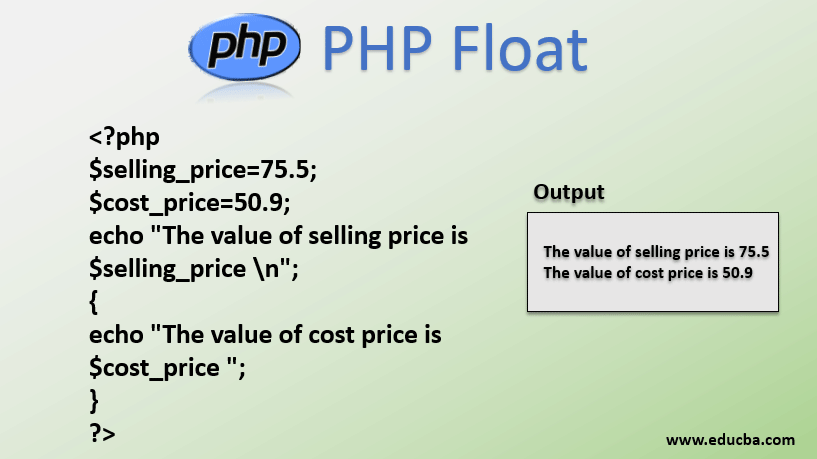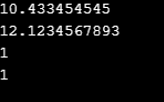Updated March 17, 2023

Introduction to PHP Float
In PHP, the Float data type is used to set fractional values. A float is a number with a decimal point and can be extended to exponential form. Float is also called a floating-point number. Various ways to represent float values are 3.14, 4.75, 5.88E+20, etc. If the values are very large and contain decimals in PHP, it automatically converts the type to float. The float has a maximum precision of about 14 digits. If the number is above the maximum digit value range, then it will lose its precision. There are few functions that can be used to check whether the data type is a float in PHP.
Programmers use the float keyword before the name of the variable so that the data type is set during the initialization of the variable. A float value can be set to a variable in the initialization phase itself by simply mentioning the name of the variable followed by an equal sign and the float/decimal value for that variable. They can change the state/value at any point of time unless they are the variable is declared as static. Mainly, a float is used in applications which include currency, marks, percentage. We can use float variables like integer variables and use basic operations such as addition, subtraction, multiplication, and division. While these operations are performed, it depends on the computer that how the output value has to be stored.
Types of Float Values
Let’s take a look at different types of floating numbers:
1. Short Floating Point Number
A short floating-point number (type short-float) is the smallest fixed precision provided by an implementation. It depends upon the PHP version that you are using to supports this datatype. Its minimum precision is 13 bits and has a minimum exponent size as 5 bits. It will be precise up to 4 decimal places.
2. Double Floating Point Number
A double floating-point number is one of the fixed precision provided by an implementation. Its minimum precision is 50 bits and the minimum exponent size is 8bits. The precision of these categories depends upon the implementation. It will be precise up to 14 decimal places.
3. Long Floating Point Number
A long floating-point number (type long-float) is one of the largest fixed precision provided by an implementation. Its minimum precision is 50 bits and the minimum exponent size is 8bits. The precision of these categories depends upon the implementation. It will be precise up to 14 decimal places. It is similar to a double floating-point number.
How does Float Work in PHP?
Float values are nothing but decimal fractions, which has their own precision. Let’s consider simple examples to understand how the float value works:
Example #1
Code:
<?php
$selling_price=75.5;
$cost_price=50.9;
echo "The value of selling price is $selling_price \n";
{
echo "The value of cost price is $cost_price ";
}
?>Output:
In the above example, the output will be the value of the variable selling price and cost price, i.e. the float values assigned to the variables will be printed on the output screen.
Let’s take another example of double float values:
Example #2
Code:
<?php
$a = 10.433454545;
$b = 12.1234567893;
echo $a;
echo "\n";
echo $b;
echo "\n";
echo is_double($a);
echo "\n";
echo is_double($b);
echo "\n";
?>Output:
In the above example, the output of the function is_double() will be checked whether the variables are of double float type or not. It just checks whether the double value is set to the variable, and in this example, both the variables have been initialized double values.
Example #3
We can do basic operations in PHP using float values:
Code:
<?php
$ab = 1.23456789;
$bc = 1.23456780;
$ep = 0.00001;
if(abs($ab-$bc) < $ep)
{
echo "true";
}
else
{
echo “false”;
}
?>Output:
The $ab variable has been initialized the decimal value and similarly to variable $bc in the above example. So, after the calculation, if the condition is satisfied and prints the true statement present inside the loop on the output screen.
The function is_float () can be used to check whether a variable is of float type or not. The is_float () is an inbuilt function in PHP. It is a Boolean function, so it returns TRUE when a type is a float, otherwise FALSE.
Let’s take a simple example.
Example #4
Code:
<?php
$a = 10.43;
$b = 55;
echo $a;
echo "\n";
echo $b;
echo "\n";
echo is_float($a);
echo "\n";
echo is_float($b);
?>Output:
In the above example, the output of the function is_float() will be true for the first echo statement and false for the second one. In this example, the output will be 1, and after the break also it will be 1. It just checks whether the float value is set to the variable, and in this example, one of the variables has been initialized float values.
Like is_float () function, we have a function called var_dump () function to print both the type and the value as output. This function is used to print the data type associated with the variable that the developers want to print on the screen.
Example #5
Code:
<?php
$a = 10.95;
echo $a;
echo "\n";
echo is_float($a);
echo "\n";
var_dump($a);
echo "\n";
?>Output:
In the above example, the output of is_float() function and var_dump function() differs. The var_dump() function will print the data type along with the value of the variable.
Conclusion
In this article, we discussed the float values and their types. Many of the Float types are used in many programs and applications where most of the activities have calculations and precisions. Float values have a vital role in many programming languages for their precision and also used in large amounts.
Recommended Articles
This is a guide to PHP Float. Here we discuss the types of Float Values, including Short Floating Point Number, Double Floating Point Number, and Long Floating Point Number, along with Examples. You can also go through our other suggested articles to learn more –





